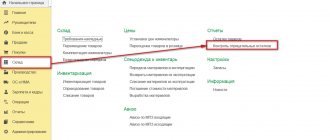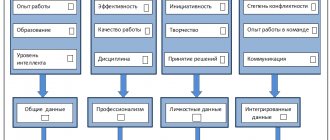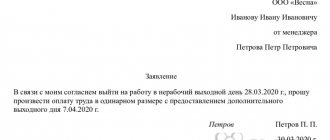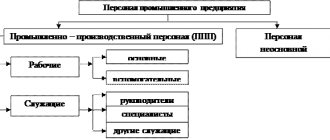Most organizations currently operate on schedules that do not include days off, meaning that an employee's workday is far from the standard eight hours. Enterprises are aimed at obtaining high profits and, accordingly, at using available resources as efficiently as possible, including without interrupting the company’s activities day or night. Accordingly, the question arises: what does “flexible work schedule” mean, what is a flexible work schedule according to the Labor Code of the Russian Federation, how does it help prevent employee overwork and achieve the best results.
Types of flexible work schedules
A flexible work schedule is a variant of organizing work time in which individual employees or teams of enterprises can (within established limits) work under conditions of self-regulation of the beginning, end and duration of the working day.
When applying the regime under consideration, it is imperative to work the total number of working hours determined by law during the accounting period (day, week, month, etc.).
The elements that make up the mode are as follows:
- variable (flexible) time at the beginning (end) of the work day (shift), within which the employee has the right (at his own discretion) to start and finish working;
- fixed time - the period during which those who have a flexible working time schedule are required to stay at the workplace;
- a break (for food), the duration of which is not actually included in working hours;
- the duration (type) of the accounting period, which establishes the time during which the employee is obliged to work the standard of time established by the legislator (this can be a day, a week, a month, etc.).
Possible mode options, which depend on the duration of the accounting period, are:
- accounting period equated to a working day (the duration established by the legislator is worked out in full on the same day);
- accounting period equal to a week (the length of the week, established in hours of work, is worked in full this week);
- accounting period equal to a month (a certain number of hours is worked in full in a given month).
Sometimes the following are used as an accounting period:
- decade;
- quarter;
- other mode options acceptable to the enterprise.
As a result, the duration of the accounting period can range from one working day to a year (Article 102, Part 1 of Article 104 of the Labor Code of the Russian Federation).
Length of day
The time intervals of the components of a flexible schedule, including the type of accounting period, are determined by the enterprise. In general, the permissible limit for day length is 10 hours .
The break for rest and meals is set between half an hour and two hours . As an exception, the maximum permissible time spent at work, including breaks, may be 12 hours . This applies to all types of accounting period except when it is set to a day.
Flexible schedule and its features
Let us tell you in more detail how to understand a “flexible schedule” and what its features are. This is a system in which the employer has the opportunity to set an individual working day for an employee.
Working according to the “g” schedule - what is it? This is the performance of state or public duties, identical for registration both in form T-12 and in form 0504421. Does this equate to the opportunity to come to the workplace when it is convenient for the employee? This is not an option, of course. In this case, the employer determines the scope of the task and the deadline for its completion. This is the work used at many foreign enterprises (for example, at Sony); Is there a flexible schedule at enterprises in our country: of course, yes, but this format is still new for the most advanced corporations.
This work regime is a form of work in which individual employees or teams as a whole can start and end the working day, as well as determine its duration within the framework of an agreement reached with the employer. However, in this case it is necessary to work out the total established standard number of labor hours in full in the agreed accounting period.
This mode is set:
- internal labor regulations (part 1 of article 100 of the Labor Code of the Russian Federation);
- an employment contract with a specific employee (if a regime is defined for him that differs from that generally accepted in the organization).
Reflection in the employment contract
What is needed: an employment contract with a new employee or the release of an agreement for the old one?
In the case where a new employee is initially hired with a flexible schedule, this is reflected in his employment contract .
an additional agreement is drawn up based on his application .
Both the employment contract and the additional agreement to it must reflect the following information :
- Full Name;
- job title;
- the period for which a flexible schedule is introduced;
- variable and fixed time;
- break time for meals and rest;
- accounting period type.
The document must indicate that changes to it can be made by mutual agreement of the parties.
Sample of an additional agreement on the establishment of flexible working hours.
Individual publications by our experts on the following topics will help employees protect their rights:
- How are technological and technical breaks organized and provided?
- Who is entitled to part-time work and how is it established and who can apply for reduced working hours?
- How long is a work shift and what is an irregular working day?
- How should a business trip on a day off be paid?
How to set a flexible schedule for an employee
Flexible work schedule - what is it? Free from obligations? The answer to the question is this: this is a clear system based on strict control and labor discipline. What does a full-time, flexible schedule mean for any employee? The latter concept implies the need for an employee to be present at the workplace for a set number of hours, without taking into account the lunch break.
In order to establish a flexible schedule (according to the Labor Code of the Russian Federation), it is necessary to agree on it between the employee and the employer. This can be done both upon admission to the institution and during work at the enterprise. The reasons for establishing such a work regime may be:
- household, social, and other conditions under which it is not possible to continue working as usual;
- economical use of working time, improving the atmosphere in the department, increasing labor productivity.
Article 102 of the Labor Code of the Russian Federation determines the possibility of establishing a flexible schedule, within which the beginning, end, and duration of work are determined by formalizing an agreement of the parties.
Thus, work on a flexible schedule is a work week of a set duration (for example, 40 hours), within which the working day can consist of 4, 8, 12 hours, but in total the employee must return to work by the end of the accounting period (week) at 40 o'clock. Employees whose work is based on such rules have the same social package from the employer as those working under the regular system: weekends, vacation, sick leave and other payments. This means that the use of such a regime does not affect the payment procedure, the procedure for calculating and the amount of payments, benefits, length of service and other labor rights.
Information that the employee has been assigned a flexible mode is indicated:
- when hiring - in an employment order issued on the basis of a concluded employment agreement (the employer has the right to use both the unified T-1 form and an independently developed one);
- in the process of work - in the text of the concluded additional agreement to the employment contract (upon signing the document, the employer issues an administrative document on the application of the working hours for a certain employee. The additional agreement with the employee must be indicated as the basis for the document. The employer can develop the form of the document himself. It must indicate position, full name of the employee for whom the regime is determined, date of introduction, fixed and variable time, break time for rest and food, duration of the accounting period. The document must be familiarized with the subordinate for signature).
Statement
The basis for transferring to a sliding schedule is his statement.
This is the first thing the employer will require as proof that the employee will not be against changes in basic working conditions.
When writing an application, it is important to remember that a flexible schedule can be established either without time limits or for any period that is convenient for the employee, so the application must contain not only the desired schedule , but also the period for which it is being implemented .
It is also worth indicating the reason for such a transition and, if desired, attaching a copy of the document confirming it. After the manager signs the application, it is sent to the personnel department, where the responsible specialist draws up an individual work schedule , an addition to the employment contract and order .
Sample application for establishing a flexible schedule.
Why is it attractive to performers?
The method of organizing work according to the option under consideration has many advantages for the employee (provided he properly performs his duties):
- independent planning of the day in a convenient format;
- coming and going at a convenient time;
- independent choice of day length;
- motivation to improve performance, based on a sense of freedom and trust of the employer;
- optimal balance between professional and personal life;
- ability to vary workload.
Results
The legislation does not provide for the procedure for calculating the hourly tariff rate, so the organization independently makes its choice , which it enshrines in local regulatory documents.
The use of GDV should not harm the production process; not all employees have sufficient self-organization skills, so making such a decision should be preceded by a thorough analysis of the possible consequences.
At the same time, the employer’s refusal to establish a flexible schedule should not contradict current legislation and internal regulations.
The main purpose of using this regime is to provide comfortable conditions for the employee, which will allow him to increase the productivity of his work.
Such a decision should contribute to the optimal combination of the economic interests of the organization with the social and personal needs of employees.
Advantages of a flexible accounting system
The employer records the labor time actually spent by the employee (Part 4 of Article 91 of the Labor Code of the Russian Federation). This is reflected in the time sheet. This document can be prepared:
- according to unified forms T-12 and T-13 (Resolution of the State Statistics Committee of the Russian Federation dated January 5, 2004 No. 1);
- according to the form developed by the employer.
The positive aspects of the accounting scheme are that the process of activity does not imply the presence of all employees at their workplaces at the same time, because a person’s individual biorhythm does not always coincide with the established mode of activity. Under such conditions, an employee can use his resources, both physical and mental, most productively.
What problems does the organization solve?
Using a flexible schedule makes it possible to avoid mistakes that are traditional in the usual management form, and also to raise the company’s rating in the eyes of its employees.
For an organization, there is a whole list of positive aspects that are important for the implementation of the system:
- eliminating the risk of losing working time due to absence, tardiness or unauthorized departure of an employee during the day (automatic recording of working time);
- avoiding overtime work;
- eliminating cases of delay;
- increasing the level of loyalty and responsibility of employees towards the organization;
- a convenient option for categories of workers who are not able to work during normal hours;
- assistance in the most expedient organization of enterprise processes;
- increasing discipline;
- the optimal balance between the personal, economic and social interests of the employee and the enterprise.
However, all this can only be used in relation to those employees who have sufficient experience and qualifications, as well as a high level of responsibility and self-discipline.
Salary
The most optimal solution is a time-based wage system with the establishment of official salaries or an hourly tariff rate.
If the accounting period for a flexible schedule is less than a month , then payment is made according to the established salary or hourly rate.
Example : Official salary of Ershova A.N. – 30,000 rubles, standard hours per month – 160, actual hours worked – 150.
Accrued salary = 30,000/160x150=28,150 rub.
Disadvantages of flexible scheduling
The introduction of such a regime implies not only the presence of advantages. The employer will need to pay attention to many aspects.
The employer will have to:
- ensure the availability of an automated control system to record employee compliance with schedules;
- develop an algorithm for ensuring proper quality of work;
- develop a mechanism for interaction between workers from different departments in cases where their simultaneous participation in the process is necessary.
Thus, the employer’s tasks will be to prevent the weakening of control, to establish coordination of actions and the process of recording work hours.







